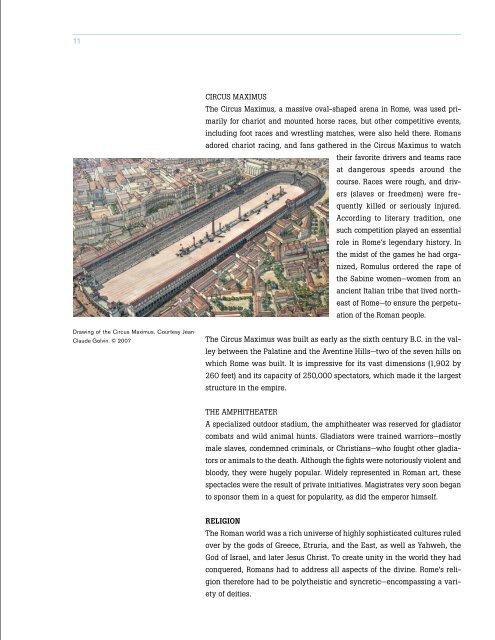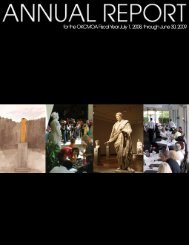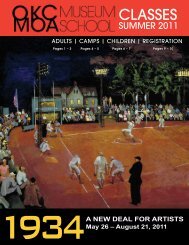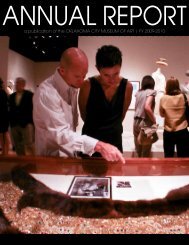Roman Art from the Louvre Educators' Resource Guide
Roman Art from the Louvre Educators' Resource Guide
Roman Art from the Louvre Educators' Resource Guide
Create successful ePaper yourself
Turn your PDF publications into a flip-book with our unique Google optimized e-Paper software.
11<br />
Circus Maximus<br />
The Circus Maximus, a massive oval-shaped arena in Rome, was used primarily<br />
for chariot and mounted horse races, but o<strong>the</strong>r competitive events,<br />
including foot races and wrestling matches, were also held <strong>the</strong>re. <strong>Roman</strong>s<br />
adored chariot racing, and fans ga<strong>the</strong>red in <strong>the</strong> Circus Maximus to watch<br />
<strong>the</strong>ir favorite drivers and teams race<br />
at dangerous speeds around <strong>the</strong><br />
course. Races were rough, and drivers<br />
(slaves or freedmen) were frequently<br />
killed or seriously injured.<br />
According to literary tradition, one<br />
such competition played an essential<br />
role in Rome’s legendary history. In<br />
<strong>the</strong> midst of <strong>the</strong> games he had organized,<br />
Romulus ordered <strong>the</strong> rape of<br />
<strong>the</strong> Sabine women—women <strong>from</strong> an<br />
ancient Italian tribe that lived nor<strong>the</strong>ast<br />
of Rome—to ensure <strong>the</strong> perpetuation<br />
of <strong>the</strong> <strong>Roman</strong> people.<br />
Drawing of <strong>the</strong> Circus Maximus. Courtesy Jean-<br />
Claude Golvin. © 2007<br />
The Circus Maximus was built as early as <strong>the</strong> sixth century B.C. in <strong>the</strong> valley<br />
between <strong>the</strong> Palatine and <strong>the</strong> Aventine Hills—two of <strong>the</strong> seven hills on<br />
which Rome was built. It is impressive for its vast dimensions (1,902 by<br />
260 feet) and its capacity of 250,000 spectators, which made it <strong>the</strong> largest<br />
structure in <strong>the</strong> empire.<br />
The Amphi<strong>the</strong>ater<br />
A specialized outdoor stadium, <strong>the</strong> amphi<strong>the</strong>ater was reserved for gladiator<br />
combats and wild animal hunts. Gladiators were trained warriors—mostly<br />
male slaves, condemned criminals, or Christians—who fought o<strong>the</strong>r gladiators<br />
or animals to <strong>the</strong> death. Although <strong>the</strong> fights were notoriously violent and<br />
bloody, <strong>the</strong>y were hugely popular. Widely represented in <strong>Roman</strong> art, <strong>the</strong>se<br />
spectacles were <strong>the</strong> result of private initiatives. Magistrates very soon began<br />
to sponsor <strong>the</strong>m in a quest for popularity, as did <strong>the</strong> emperor himself.<br />
Religion<br />
The <strong>Roman</strong> world was a rich universe of highly sophisticated cultures ruled<br />
over by <strong>the</strong> gods of Greece, Etruria, and <strong>the</strong> East, as well as Yahweh, <strong>the</strong><br />
God of Israel, and later Jesus Christ. To create unity in <strong>the</strong> world <strong>the</strong>y had<br />
conquered, <strong>Roman</strong>s had to address all aspects of <strong>the</strong> divine. Rome’s religion<br />
<strong>the</strong>refore had to be poly<strong>the</strong>istic and syncretic—encompassing a variety<br />
of deities.
















